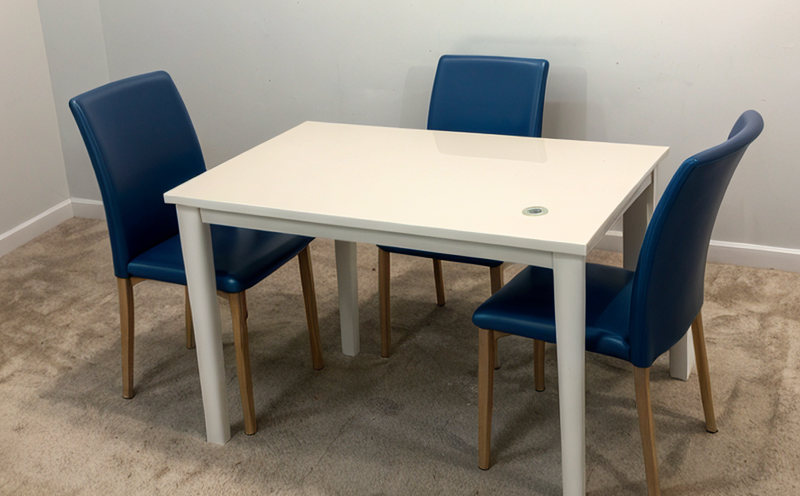UNE EN 12720 Resistance to Cold Liquids Testing of Furniture Plastics
The UNE EN 12720 standard is an essential requirement for manufacturers and suppliers in the furniture sector, ensuring that plastics used in furniture are capable of withstanding cold liquids without compromising safety or functionality. This test evaluates the resistance to cold liquid immersion of plastics intended for use in furniture, which may come into contact with water or other cool fluids during normal usage.
The standard is particularly important because many plastic materials used in furniture can undergo significant changes when exposed to cold liquids, affecting their flexibility and durability. UNE EN 12720 helps manufacturers ensure that their products meet the required performance standards, thereby enhancing consumer safety and satisfaction. The test procedure involves immersing specimens of the plastics into a cold liquid for a specified duration before evaluating them according to specific criteria.
Understanding the implications of this testing is crucial for quality managers, compliance officers, R&D engineers, and procurement teams involved in the production or sourcing of furniture plastics. This service ensures that all materials used meet the stringent requirements set by UNE EN 12720, which are critical for maintaining high standards across the furniture industry.
The testing process involves several key steps:
- Selection and preparation of the plastic specimens
- Immersion in a cold liquid at specified temperatures
- Visual inspection and dimensional measurement post-immersion
- Evaluation against predefined criteria for acceptable performance
The primary goal is to assess how well the plastic materials retain their integrity, shape, and function after exposure to cold liquids. This service provides detailed reports that highlight any deviations from standard expectations, allowing manufacturers to identify potential issues early in the development process.
| Test Procedure | Expected Outcomes |
|---|---|
| Immersion in cold liquid for a specific duration | Evaluation of the material's resistance to cold temperatures |
| Visual inspection and dimensional checks | Determination of any changes in appearance or shape |
| Evaluation against predefined criteria | Assessment of compliance with UNE EN 12720 standards |
The testing procedure is meticulously designed to mimic real-world conditions, ensuring that the materials used in furniture are reliable and safe. This service not only adheres to international standards but also provides valuable insights into material performance under cold conditions.
For manufacturers and suppliers, this test ensures that their products meet regulatory requirements and consumer expectations. By offering comprehensive testing services aligned with UNE EN 12720, we help companies maintain a competitive edge in the furniture market while ensuring product safety and durability.
Industry Applications
- Furniture manufacturers: Ensure compliance with international standards for cold resistance of plastics used in furniture.
- R&D engineers: Develop new materials that meet stringent requirements without compromising on performance or aesthetics.
- Compliance officers: Verify that all products adhere to regulatory guidelines and industry best practices.
- Sourcing teams: Identify suppliers who provide materials that pass rigorous cold resistance testing.
The service is widely used across various sectors, including home furnishings, office furniture, and outdoor seating. It ensures that the plastics used in these applications can withstand cold temperatures without degrading, maintaining both safety and comfort for end-users.
Customer Impact and Satisfaction
- Enhanced Safety: Products that meet UNE EN 12720 standards are less likely to pose a risk of injury or damage due to cold exposure.
- Durability: Materials that pass this test are more resilient, extending the lifespan of furniture and other products made from them.
- Consumer Confidence: Compliance with international standards builds trust among consumers who value quality and safety in their purchases.
The service directly impacts customer satisfaction by ensuring that products perform as expected under a variety of conditions. This is particularly important for furniture items, which are often exposed to environmental factors such as cold temperatures during use.
Use Cases and Application Examples
- Outdoor furniture: Chairs, tables, and benches that come into contact with rain or dew require plastics resistant to cold conditions.
- Office furniture: Desks, chairs, and other items used in offices where temperature fluctuations can occur.
- Home furnishings: Sofas, armchairs, and cushions that are frequently exposed to ambient temperatures including cold ones.
| Furniture Type | Cold Liquid Exposure Conditions | Tested Materials |
|---|---|---|
| Outdoor Chairs | Rain and dew | Polyethylene, Polypropylene |
| Office Desks | Temperature fluctuations | PVC, ABS |
| Home Sofas | Ambient conditions | PET, POM |
The service is essential for any manufacturer or supplier dealing with cold resistance in plastics used in furniture. It ensures that products are not only safe but also meet the highest standards of quality and durability.





